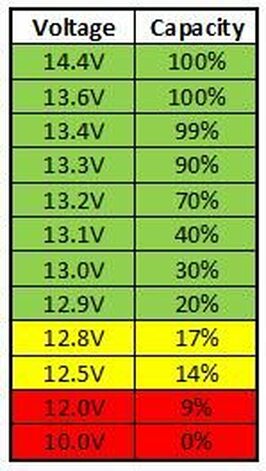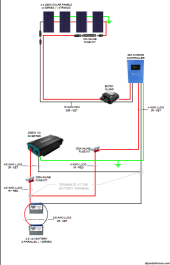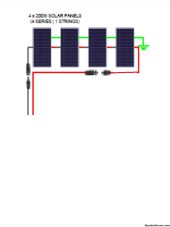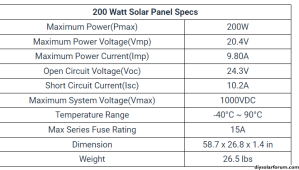What do you mean pull the fuse out of the loop?You only have 1 string there, pull the fuse out of the loop.
11.8 on a LFP is pretty much dead. 12v is about 10% charged, a little less.
.

If your batteries are at 12v, they'll run dry in a few minutes at best. You gotta get those batteries charged up!
You are using an out of date browser. It may not display this or other websites correctly.
You should upgrade or use an alternative browser.
You should upgrade or use an alternative browser.
Newbie -no idea about electric/solar-with fast-draining batteries
- Thread starter lflock
- Start date
Rednecktek
Solar Wizard
Not clear about what you mean:
I understand leaving them connected, but when I test, don't I have to unplug at the panel?
No. Where the wires come from the panels into the SCC there are a couple screws holding the wires in, right? Put the meter probes on those screws when you measure voltage. The screen on the SCC and your meter Should read about the same if the panels are working correctly. You have 3 panels in series? You should see somewhere around 105v or so hopefully. The big key si what the meter says is coming into those screws when your SCC goes into "Moon Mode".
I made a mistake before, they are hooked up according to Rich Solar, positive to neg, for three panels. Only way the plugs work.Are your 3x 200W panels in series, or in parallel?
What are the ratings on the label?
I'm wondering why fuse blew. Series panels it shouldn't, parallel it would.
Rednecktek
Solar Wizard
Take the inline fuse out and connect the wires without it. It's just adding 3 more points of failure on a single string where you don't need it.What do you mean pull the fuse out of the loop?
Rednecktek
Solar Wizard
Uhhh.... no. If the panels are connected to each other then it's Pos -> Neg -> Pos -> Neg -> Pos -> Neg -> SCC. If you're connecting positive to positive it requires a splitter or combiner box of some sort.Hooked up according to Rich Solar, positive to positive, negative to neg. That is the only way the plugs work on the panels.
Hedges
I See Electromagnetic Fields!
- Joined
- Mar 28, 2020
- Messages
- 21,532
What do you mean pull the fuse out of the loop?
A single fuse in a PV wire performs no useful function.
You could shut things off, remove fuse holder, connect wires to complete circuit with no fuse.
Hooked up according to Rich Solar, positive to positive, negative to neg. That is the only way the plugs work on the panels.
That sounds like parallel. And not what their drawing shows. Please reconfirm.

Rednecktek
Solar Wizard
Yes, neg to pos to neg to pos...for 3 panels. I made a mistake in writing, brain fart if you will, the panels are hooked pos to neg. I just went and confirmed.Connected like this (left to right) it's SCC Negative -> Neg -> Pos -> Neg -> Pos ->Neg -> Pos -> SCC Positive. No in line fuse needed.
View attachment 170940
Like this:
Hedges
I See Electromagnetic Fields!
- Joined
- Mar 28, 2020
- Messages
- 21,532
PV panels Isc spec may or may not approach fuse rating. Fuse may not blow quite that easily.
Fuse should be rated 1.56x Isc as a minimum, whatever "max fuse" on PV panel label as a maximum.
Flaky contact is a distinct possibility. Just remove fuse from the circuit.
Fuse should be rated 1.56x Isc as a minimum, whatever "max fuse" on PV panel label as a maximum.
Flaky contact is a distinct possibility. Just remove fuse from the circuit.
Okay, the panels are now charging, so if it goes to sleep soon, I will do as you suggest and check at the SCC.No. Where the wires come from the panels into the SCC there are a couple screws holding the wires in, right? Put the meter probes on those screws when you measure voltage. The screen on the SCC and your meter Should read about the same if the panels are working correctly. You have 3 panels in series? You should see somewhere around 105v or so hopefully. The big key si what the meter says is coming into those screws when your SCC goes into "Moon Mode".
can't say if series or parallel, they are pos to neg for 3 panels, and the ratings areAre your 3x 200W panels in series, or in parallel?
What are the ratings on the label?
I'm wondering why fuse blew. Series panels it shouldn't, parallel it would.
Attachments
Rednecktek
Solar Wizard
That's series. You should see about 60-ish volts at the SCC when it's charging so double check that now that it's up and working. When it goes to Moon Mode check it again and see if you still have 60ish volts.can't say if series or parallel, they are pos to neg for 3 panels, and the ratings are
Also, while you're out there futzing with that inline fuse, go snug up all the other connections too. Can't hurt.
Okay, checked, SCC is showing panels 56-57 v. It is late afternoon and the panels are not set up for optimal exposure, so I suppose that is okay.That's series. You should see about 60-ish volts at the SCC when it's charging so double check that now that it's up and working. When it goes to Moon Mode check it again and see if you still have 60ish volts.
Also, while you're out there futzing with that inline fuse, go snug up all the other connections too. Can't hurt.
I "snugged" up the other connections when I reattached them.
I assume you mean check the SCC if it goes into sleep mode while the sun is still out.
The rating is 15a, that's all it says.PV panels Isc spec may or may not approach fuse rating. Fuse may not blow quite that easily.
Fuse should be rated 1.56x Isc as a minimum, whatever "max fuse" on PV panel label as a maximum.
Flaky contact is a distinct possibility. Just remove fuse from the circuit.
Okay, all, the system seems to be good without the inline fuse. Don't understand why it why required in the first place. I thank all who gave suggestions and cared enough to respond, my gratitude goes out to you. Now, I have to figure out why it is draining. The RV does not have much going on inside as I stated before. It seems the fridge is the culprit and I will watch today how the SCC responds when it is turned on. But, it supposedly is 9.4v, so unless there is redundancy that has kicked in(according to the manual) which would make it run continuously, I don't understand how the 2000w solar unit is not keeping up.
Hedges
I See Electromagnetic Fields!
- Joined
- Mar 28, 2020
- Messages
- 21,532
"except mine came only with 3 200w panels"
3 x 200W = 600W STC. That's full sun, panels at 25 degrees C.
Realistic conditions, maybe 450W. 5 hours effective sun, 2250 Wh/day (less in winter. Less when tilt doesn't match season.)
Don't know the no-load current draw of inverter. That may consume significant fraction.
It takes equipment, DMM and clamp DC ammeter, to investigate these systems.
Fridge power draw and percentage of time on is the other big thing to consider.
3 x 200W = 600W STC. That's full sun, panels at 25 degrees C.
Realistic conditions, maybe 450W. 5 hours effective sun, 2250 Wh/day (less in winter. Less when tilt doesn't match season.)
Don't know the no-load current draw of inverter. That may consume significant fraction.
It takes equipment, DMM and clamp DC ammeter, to investigate these systems.
Fridge power draw and percentage of time on is the other big thing to consider.
Would you suggest more panels and batteries? Luckily, I live in central Mexico where we receive - if I remember correctly - around 350 days of pure sunshine. The other days, during the summer, the days are rarely solid clouds."except mine came only with 3 200w panels"
3 x 200W = 600W STC. That's full sun, panels at 25 degrees C.
Realistic conditions, maybe 450W. 5 hours effective sun, 2250 Wh/day (less in winter. Less when tilt doesn't match season.)
Don't know the no-load current draw of inverter. That may consume significant fraction.
It takes equipment, DMM and clamp DC ammeter, to investigate these systems.
Fridge power draw and percentage of time on is the other big thing to consider.
What does no-load current draw of inverter mean? On the specs it says: 2000w output, input 12v, output 100-120v ac 60hz.
Rednecktek
Solar Wizard
Would you suggest more panels and batteries? Luckily, I live in central Mexico where we receive - if I remember correctly - around 350 days of pure sunshine. The other days, during the summer, the days are rarely solid clouds.
Definitely more panels. Your 300w set right now might fill a single battery in a day if it never gets used, but not 2 and not enough to fill a battery AND run anything else. For 200Ah of batteries the math looks something like this:
12.8v @ 100Ah = 1280 watt hours (Wh) of power *2 batteries = 2500Wh of power.
2500Wh / 5 average good direct straight sun hours = 500w
So you'd need at least 500w of solar panel in perfect conditions in direct straight on sun at perfect room temperature to fill those batteries in a day. You've got that so
Then there are the loads you want to run during the day and if you have a guess as to how much that draw is, add that up in panels.
All inverters have electronics inside that stay on and need a little power just to exist standing by ready to do anything. That's called "No load draw" or "Standby Draw" and usually it's not much, but the larger the inverter the more power it needs just to sit there and exist. As an example, my Growatt 3Kw unit uses about 60w just sitting there turned on ready to go which doesn't sound like much, but when it's 60w for 24 hours it adds up to about 25% of my 8Kwh battery to do nothing. Stand alone inverters in your size are probably somewhere in the 20w range, or about 500Wh a day just sitting there. When you're using standard 100Ah LFPO batteries, that's almost half a battery a day in standby.What does no-load current draw of inverter mean? On the specs it says: 2000w output, input 12v, output 100-120v ac 60hz.
There are inverters that use very little standby power, but IMHO they're not worth it because the cost difference between a 20w draw inverter and a 5w draw inverter is usually around the same price as 2 or 3 more batteries.
The big issue I keep coming back to here is where your batteries are down in the 11v range, that's bone dry dead! Those batteries need to get charged up because while you may have 2500Wh of capacity, there only seems to be about 250Wh actually in the tank. Do you have/can you beg/borrow/steal a regular battery charger from someone and throw that on the batteries? A regular battery charger will get you up into the 90%ish range at least and you can connect it up right along side the solar array (just clamp the terminals to the batteries, it's fine) and let the charger help out the solar.
I think if you got the batteries fully charged you'd see a world of difference in how things run.
I have 3 200w panels and 2 12v lith. 100ah batteries.Definitely more panels. Your 300w set right now might fill a single battery in a day if it never gets used, but not 2 and not enough to fill a battery AND run anything else. For 200Ah of batteries the math looks something like this:
12.8v @ 100Ah = 1280 watt hours (Wh) of power *2 batteries = 2500Wh of power.
2500Wh / 5 average good direct straight sun hours = 500w
So you'd need at least 500w of solar panel in perfect conditions in direct straight on sun at perfect room temperature to fill those batteries in a day. You've got that so
Then there are the loads you want to run during the day and if you have a guess as to how much that draw is, add that up in panels.
All inverters have electronics inside that stay on and need a little power just to exist standing by ready to do anything. That's called "No load draw" or "Standby Draw" and usually it's not much, but the larger the inverter the more power it needs just to sit there and exist. As an example, my Growatt 3Kw unit uses about 60w just sitting there turned on ready to go which doesn't sound like much, but when it's 60w for 24 hours it adds up to about 25% of my 8Kwh battery to do nothing. Stand alone inverters in your size are probably somewhere in the 20w range, or about 500Wh a day just sitting there. When you're using standard 100Ah LFPO batteries, that's almost half a battery a day in standby.
There are inverters that use very little standby power, but IMHO they're not worth it because the cost difference between a 20w draw inverter and a 5w draw inverter is usually around the same price as 2 or 3 more batteries.
The big issue I keep coming back to here is where your batteries are down in the 11v range, that's bone dry dead! Those batteries need to get charged up because while you may have 2500Wh of capacity, there only seems to be about 250Wh actually in the tank. Do you have/can you beg/borrow/steal a regular battery charger from someone and throw that on the batteries? A regular battery charger will get you up into the 90%ish range at least and you can connect it up right along side the solar array (just clamp the terminals to the batteries, it's fine) and let the charger help out the solar.
I think if you got the batteries fully charged you'd see a world of difference in how things run.
As for the no-load draw, found that this morning in the manual-<2.0a
The SCC is showing the batteries at 100% and I checked the setting on the SCC finally and it is set to lithium.
Rednecktek
Solar Wizard
Ok, so good on panels. Your batteries should be 14.4 or so when you put a meter on them with the sun shining (leave everything connected to make sure the SCC is kicking out the right voltage) because the meter on the SCC is programmed for lead acid and doesn't mean much.
2a is still 24w which over a day is half a battery. Not horrible.
Dig into the manual and read the instructions for setting USR mode. One thing I've seen repeatedly is the SCC comes programmed for lead acid (12.8v) and if you just change it to LiFE it keeps the same settings (12.8) so I've had to set it to USR, set the charge (14.6v) and float (14.2v) and THEN set it to LiFE. It's annoying but 90% of your battery capacity is between 13v and 14v so 12.8v does jack squat.
2a is still 24w which over a day is half a battery. Not horrible.
Dig into the manual and read the instructions for setting USR mode. One thing I've seen repeatedly is the SCC comes programmed for lead acid (12.8v) and if you just change it to LiFE it keeps the same settings (12.8) so I've had to set it to USR, set the charge (14.6v) and float (14.2v) and THEN set it to LiFE. It's annoying but 90% of your battery capacity is between 13v and 14v so 12.8v does jack squat.
Rednecktek
Solar Wizard
That sounds low, dig into the manual and see what it's charging at. 13.6v is about 25% full, there's a looonnnggg way to go before that moves up and gets full.
Will doThat sounds low, dig into the manual and see what it's charging at. 13.6v is about 25% full, there's a looonnnggg way to go before that moves up and gets full.
Rednecktek
Solar Wizard
Also, don't panic if it looks like the battery isn't getting any charge, you're just hitting the curve and it's going to suck a LOT of amps from the array before the voltage goes up.
That's normal, don't worry.
That's normal, don't worry.
Okay, going through manual, which is not clear at all to a newbie, I found the float charge in the manual-where I would input it, but it does not clearly state which is the charge setting: bunch of different "charge" listings: such as charging limit voltage, equalizing charging voltage, boost charging voltage, etc...what should I be looking for?Ok, so good on panels. Your batteries should be 14.4 or so when you put a meter on them with the sun shining (leave everything connected to make sure the SCC is kicking out the right voltage) because the meter on the SCC is programmed for lead acid and doesn't mean much.
2a is still 24w which over a day is half a battery. Not horrible.
Dig into the manual and read the instructions for setting USR mode. One thing I've seen repeatedly is the SCC comes programmed for lead acid (12.8v) and if you just change it to LiFE it keeps the same settings (12.8) so I've had to set it to USR, set the charge (14.6v) and float (14.2v) and THEN set it to LiFE. It's annoying but 90% of your battery capacity is between 13v and 14v so 12.8v does jack squat.
Similar threads
- Replies
- 2
- Views
- 154
- Replies
- 1
- Views
- 125
- Replies
- 11
- Views
- 720
- Replies
- 12
- Views
- 670
- Replies
- 30
- Views
- 1K




